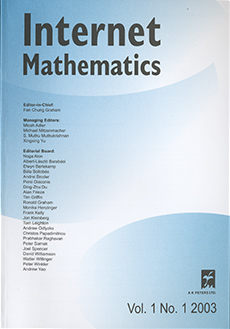Abstract
By extending Heider's and Cartwright–Harary's theory of balance in deterministic social structures, we study the problem of balance in social structures in which relations among individuals are random. An appropriate model for representing such structures is that of random signed graphs $G_{n,p,q}$, defined as follows. Given a set of $n$ vertices and fixed numbers $p$ and $q$, $0 \lt p + q \lt 1$, then between each pair of vertices, there exists a positive edge, a negative edge, or no edge with respective probabilities $p, q, 1 − p − q$.
We first show that almost always (i.e., with probability tending to 1 as $n \to \infty$), the random signed graph $G_{n,p,q}$ is unbalanced. Subsequently we estimate the maximum order of a balanced induced subgraph in $G_{n,p,p}$ and show that its order achieves only a finite number of values. Next, we study the asymptotic behavior of the degree of balance and give upper and lower bounds for the line index of balance. Finally, we study the threshold function of balance, e.g., a function $p_0 (n)$ such that if $p \gg p_0 (n)$, then the random signed graph $G_{n,p,p}$ is almost always unbalanced, and otherwise, it is almost always balanced.
Citation
A. El Maftouhi. Y. Manoussakis. O. Megalakaki. "Balance in Random Signed Graphs." Internet Math. 8 (4) 364 - 380, 2012.
Information




